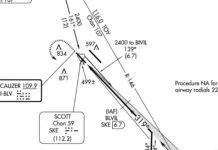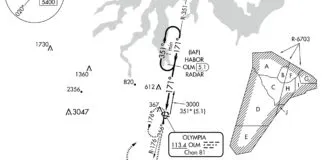Instrument currency is a pain in the tuchus. Convergence of soupy weather, aircraft availability, and free time rarely occurs. Even flying weekly, as I do, results in few actual instrument approaches. Unlike with landings, you can’t maintain instrument currency on your own in VMC without a safety pilot or instructor.
Detailed currency requirements aim to keep us safe. The feds know we need options in our quest for currency, but options make for complex rules. Simple rules, though, can be onerous and encourage pencil-whipping currency. So, options abound. We’ll look at legal currency, but I’ll point out that proficiency isn’t necessarily the same.
The Basics
There are two broad methods for maintaining currency; an instrument proficiency check (IPC) or experience. Both are found in 14 CFR 61.57.
The IPC is described in 61.57(d). It requires an instructor or examiner to check tasks from the instrument practical test standards. See the table on this page for an IPC summary. Ultimately, the person giving the IPC is responsible to ensure “the competence of the applicant to operate in the IFR environment.”
The experience method requires a minimum amount of—wait for it—actual experience. Interestingly, proficiency isn’t required; the requirement is to fly, not fly well.
There are five ways to get this experience. Most of us use the first one—log the requirements during actual flights. Doing that in a flight simulator (FS) or flight training devices (FTD) also qualifies, and is another option, but few of us have access to these bazillion-dollar toys.
Lots of Options
With the increased availability of FTDs and PC aviation training devices the FAA in 2007 added options for maintaining currency using these devices. Options three through five resulted.
The third option is actually pretty cool, but it comes with one big catch. Currency can be maintained solely in aviation training devices (ATD, the replacement term for PCATDs), like the TD by Redbird. But three hours of instrument time and four unusual attitude recoveries (two high-speed-descending and two low-speed-ascending) are added to the experience requirements of options one and two.
Options four or five utilize a combination of airplane, FS/FTD, and ATD. An IPC in an airplane is much cheaper.
Option four uses an airplane, FS/FTD, and ATD. In an airplane and FS/FTD do an approach, holding and intercepting and tracking courses. Then in an ATD do six more approaches, holding and intercepting, and tracking. Yes, that’s eight approaches, three holds, and three intercepting and tracking.
Simplified slightly is option five. It uses a FS/FTD and ATD. Six approaches, holding, and intercepting and tracking are required in both the FS/FTD and ATD. Four unusual attitudes and a minimum of three hours are needed in the ATD. We’re up to 12 approaches, four unusual attitudes, three hours in an ATD, two holds, and two intercepting and tracking (and a partridge in a pair tree?). This option is utterly pointless. The simulator portion satisfies the requirements for option two so there is no need for the ATD work.
Mired in complication, FSDO level operations inspectors don’t even understand options four and five. Talking to FSDOs across the country, I received varying answers to what constitutes a combination, what is actually required, and why someone would use option five.
The FAA even confused itself. When options were added in 2007, the combinations included the word “or” between types. Option four read airplane, simulator/FTD or ATD. The 2009 update in the Federal Register changed the word to “and” requiring all. IFR is awaiting an official response from the FAA’s Chief Counsel’s office to verify this.
Responses to the 2009 rulemaking pointed out the pointlessness of some of the options. The FAA replied that it wanted to provide as many options as possible. That’s a good intention, if a long, circuitous path to where good intentions often lead.
Backstory
Many of these peculiarities resulted from internal debates. For example, the 2007 proposed rules included hour requirements along the way to the six approaches, holdings, and one hour of simulated cross-country procedures (intercepting and tracking courses).
Most of the hour requirements were removed from the final rule. The only hour specific requirements left are the three hours associated with an ATD. As a result, the value of options four and five were greatly reduced.
Using an ATD to maintain currency could have been great. In 2009, the feds argued that since an instructor is not required to maintain instrument currency in a plane in instrument conditions:
A person who is instrument current or is within the second 6-calendar month period need not have a flight instructor or ground instructor present when accomplishing the approaches, holding, and course intercepting/tracking tasks in an approved flight training device or flight simulator. (Federal Register Vol. 74, No. 61)
This little tidbit helps justify turning the basement into an ATD hanger to simply keep yourself current at home. That has the bonus of making it much easier to maintain a two-month look-back with just a little time in the basement.
Unfortunately, instrument currency is verified by a written record which is governed by 61.51 and not comments in the Federal Register. Section (g) describes logging instrument time. It states:
A person can use time in a flight simulator, flight training device, or aviation training device for… instrument recency experience, provided an authorized instructor is present to observe that time and signs the person’s logbook or training record to verify the time and the content of the training session. (61.51(g)(4))
Interestingly, this regulation appeared in the same federal register as the 61.57 change arguing that currency can be maintained without an instructor. A close reading reveals differences between the federal register and final GPO version of the regs. The register reads an instructor is required for “aeronautical experience for meeting the requirements for a certificate, rating, or flight review.” Instrument recency experience was not included. I’m not going to argue this one with the feds. Just make sure an instructor signs for sim, FTD, or ATD time.
Currency Isn’t Proficiency
Non-certified systems (Redbird Jay, or home-built sims) are terrific for proficiency but don’t get you legal currency. While I won’t address maintaining proficiency, know that a surprising number of incidents occur among pilots trying to maintain currency. In one report, two retired airline pilots misread the approach chart and descended early. The reporter indicated that they were 600 feet above houses before recognizing the error and were lucky no towers lurked in the mist. The pilots learned their lesson commenting, “how rusty you get just staying current when you don’t fly real IFR a lot.” (ASRS ACN:1002935)
Instrument training increases comfort with clouds. Being able to fly an approach or navigate by instruments is a great safety tool but can become a broken crutch. Being out of currency, pilots fly into lower weather conditions than they would as a VFR-only pilot. Then, when stuck between a rock and IMC, use instrument skills to save themselves.
In reality, ATC doesn’t know if you’re current and an inspector likely won’t be waiting for you upon shutdown (especially if it is a weekend, holiday, evening, or later in the fiscal year when funds for field trips dry up). Instead of scud running, some pilots will just file and fly IFR. If you’re going to break rules, do it smartly like a Wall Street banker instead of an Occupy vagabond.
Occasionally ASRS reports shock. The pilot in one report clearly wasn’t legally current despite his claims. He filed a report following a seriously bungled hold. In his report, he states he “had not done a hold since practice for the instrument ticket [four years earlier]” and “had never done L turns in a hold.” (ASRS ACN:320560) Seriously? Holding procedures are required for every experience method of maintaining currency and for an instrument proficiency check. Clearly this guy does not understand his responsibilities as a pilot.
Easing the Pain
Maintaining instrument currency is a pain. Two broad methods exist, taking an IPC every six months or meeting experience requirements. Taking the experience path, you have five options. The first two utilize the normal six approaches, holding and, intercepting and tracking. Using an ATD, as described in option three, adds a time requirement and unusual attitudes. Although well intended, the combinations are a waste of money. If contemplating one of these, you might as well just do an IPC. It will likely save you time and money.
Out of six month currency, you have another six months to re-establish currency. If not, you’re stuck doing an IPC. An IPC isn’t a bad deal. Your local instructor would like the business and you might learn something new. Plus he’ll confirm you’re as good as check-ride day. Just because currency can be maintained with sloppy approaches and misshaped holds doesn’t mean it should be. Dog food is edible too, but I prefer a steak.
As a professional pilot and instrument instructor, Jordan Miller tries to avoid this whole mess by just maintaining currency in his normal flying.




